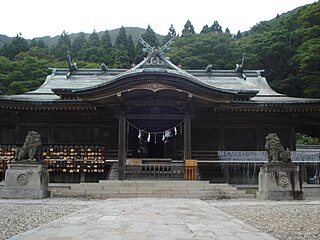 W
WHakodate Hachiman Shrine is a Shinto shrine located in Hakodate, Hokkaido. It is a Hachiman shrine, dedicated to the kami Hachiman. It was established in 1445. Its main festival is held annually on August 15. Kami enshrined here include Hondawake no mikoto (品陀和気命), Sumiyoshi no Okami (住吉大神), and Kotohira no Okami (金刀比羅大神). It was formerly a National Shrine of the Second Rank in the modern system of ranked Shinto Shrines.
 W
WKashima Shin-ryū (鹿島神流) is a Japanese koryū martial art whose foundation dates back to the early 16th century. The art developed some notoriety in Japan during the early 20th century under Kunii Zen'ya (1894-1966), the 18th generation sōke (headmaster). The current sōke is the 21st generation, Kunii Masakatsu. While the line is still headed by the Kunii family, the title of sōke is now largely honorific, and the responsibility for the preservation and transmission of the ryūha now lies in the shihanke line, currently represented by the 19th generation, Seki Humitake.
 W
WKōkukuji Castle was a Sengoku period yamashiro-style Japanese castle located in what is now part of the city of Numazu, Shizuoka prefecture. The site has been protected by the central government as a National Historic Site since 1975.
 W
WTakatenjin Castle was a Sengoku period yamashiro-style Japanese castle located in what is now part of the city of Kakegawa, Shizuoka prefecture. The site has been protected by the central government as a National Historic Site since 1975.
 W
WTochio Castle was a castle structure in Nagaoka, Niigata, Japan. Uesugi Kenshin spent his youth in the castle.
 W
WTokyo, officially Tokyo Metropolis , is the capital and most populous prefecture of Japan. Located at the head of Tokyo Bay, the prefecture forms part of the Kantō region on the central Pacific coast of Japan's main island of Honshu. Tokyo is the political and economic center of the country, as well as the seat of the Emperor of Japan and the national government. In 2019, the prefecture had an estimated population of 13,929,280. The Greater Tokyo Area is the most populous metropolitan area in the world, with more than 37.393 million residents as of 2020.
 W
WThe Tosa school of Japanese painting was founded in the early Muromachi period, and was devoted to yamato-e, paintings specializing in subject matter and techniques derived from ancient Japanese art, as opposed to schools influenced by Chinese art, notably the Kanō school (狩野派). Tosa school paintings are characterised by "areas of flat opaque colour enclosed by simple outlines, where drawing is precise and conventional", with many narrative subjects from Japanese literature and history. However, by the 17th century both Tosa and Kanō artists broadened their range, and the distinction between these and other schools became less clear.
 W
WYamanaka Castle was a Sengoku period yamajiro-style Japanese castle, built by the Odawara Hōjō clan in Tagata District, Izu Province, in what is now eastern Mishima, Shizuoka Prefecture, Japan. The site has been protected by the central government as a National Historic Site since 1988.